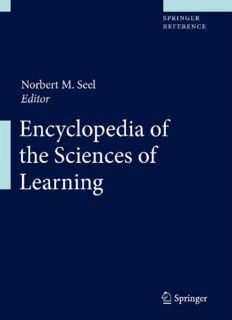Table Of ContentEncyclopedia of the Sciences of Learning
Norbert M. Seel (Ed.)
Encyclopedia of
the Sciences of Learning
With312Figuresand68Tables
Editor
Prof.Dr.NorbertM.Seel
FacultyofEconomicsandBehavioralSciences
DepartmentofEducation
UniversityofFreiburg
79085Freiburg
Germany
ISBN978-1-4419-1427-9 e-ISBN978-1-4419-1428-6
DOI10.1007/978-1-4419-1428-6
ISBNBundle978-1-4419-5503-6
SpringerNewYorkDordrechtHeidelbergLondon
LibraryofCongressControlNumber:2011934763
©SpringerScienceþBusinessMedia,LLC2012
Allrightsreserved.Thisworkmaynotbetranslatedorcopiedinwholeorinpartwithoutthewrittenpermissionofthepublisher(Springer
ScienceþBusinessMedia,LLC,233SpringStreet,NewYork,NY10013,USA),exceptforbriefexcerptsinconnectionwithreviewsor
scholarlyanalysis.Useinconnectionwithanyformofinformationstorageandretrieval,electronicadaptation,computersoftware,orbysimilar
ordissimilarmethodologynowknownorhereafterdevelopedisforbidden.
Theuseinthispublicationoftradenames,trademarks,servicemarks,andsimilarterms,eveniftheyarenotidentifiedassuch,isnottobetaken
asanexpressionofopinionastowhetherornottheyaresubjecttoproprietaryrights.
Printedonacid-freepaper
SpringerispartofSpringerScienceþBusinessMedia(www.springer.com)
Preface
Learningisexistential,andsoitsstudymustbecomplexandinterdisciplinary.Overthepastcenturies,researchers
fromdifferentfieldshavepositedmanytheoriestoexplainhowhumansandanimalslearnandbehave,i.e.,how
they acquire, organize, and deploy knowledge and skills. Basically, learning is defined as a relatively permanent
change in behavior and/or in mental associations due to experience. Learning is a response to environmental
requirementsanddifferentfrombiologicalmaturation,which,however,isafundamentalbasisforlearning.
Fromahistoricalpointofview,learninghadbeenanissueofepistemologyandphilosophysinceancienttimes.
Nevertheless,thetwentiethcenturymaybeconsideredasthecenturyofpsychologyoflearningandrelatedfieldsof
interest,suchasmotivation,cognition,andmetacognition.Itisreallyfascinatingtoseethevariouscurrentsofthe
twentiethcenturyresearchinlearning,remembering,andforgetting.Anditisinterestingtoseethatmanybasic
assumptions of early theories have survived the paradigm shifts of psychology and epistemology that occurred
during the twentieth century. Beyond folk psychology and na¨ıve theories of learning, psychological learning
theories can be grouped into several basic categories, such as behaviorist and connectionist learning theories,
cognitivelearningtheories,andsociallearningtheories.
However, learning theories are not limited to psychology and related fields but can be traced back to ancient
philosophers, such as Socrates, Plato, and Aristotle. It is certainly true that the topic of learning also played
a significant role in the philosophy of the Middle Ages (e.g., St. Thomas Aquinas), and in the modern era
philosophers such as Descartes, Hume, Locke, Kant, and many others were interested in the topic. The same
holdstrueforphilosophersofthetwentiethcentury,whowerehighlyinterestedinlearning.
It is noteworthy that the so-called fathers of psychology as a discipline, Wilhelm Wundt (1832–1920) and
WilliamJames(1842–1910),werebothoriginally professorsofphilosophy.Inthe1880s,Wundtbeganstudying
rotelearningoflistsofnonsenseverbalitems,andashorttimelater,Jamesforeshadowedmanyaspectsofmodern
neurobiologyoflearningandevenconnectionisttheory.WhereasWundtandJamesremainedcloselyalignedwith
thefieldofphilosophyandtheapplicationofintrospectiveself-observation,HermannEbbinghaus(1850–1909)
began studying human memory and higher cognitive processes (such as meaningful learning) by means of
experimentalmethods.Thistransportedthestudyoflearningandrememberingoutofphilosophyandintothe
realm of empirical research, providing valuable tools until today. Ebbinghaus’ seminal work on learning and
remembering can be considered as the beginning of systematic psychological research on learning and remem-
bering for the twentieth century. Another strong influence was Pavlov’s reflexology and his experiments with
animals.Thiscanbeconsideredasthebeginningofresearchonanimallearning,whichwasalsocharacteristic,to
a large extent, of the emerging fields of associative psychology (e.g., Thorndike) and Gestalt psychology (e.g.,
Ko¨hler).Atthebeginningofthetwentiethcentury,thesetwosources–associativepsychologyandreflexology–
gaverisetoconnectionism andtheideaoflearning bytrial anderror,whosemost prominentsupporter became
Thorndike(1874–1949).
Clearly,thefirsthalfofthiscenturywasstronglyinfluencedbyconnectionism(andbehaviorism)andGestalt
psychology,whereasthesecondhalfcanbeconsideredastheperiodoftheemergenceofcognitiveandconstruc-
tivistconceptionsoflearning.Psychologistsandbiologistshavestudiedlearninginanimalsandhumanswithinthe
realmofbothparadigms.Nowadays,animalandhumanlearningandcognitionareseparatebutrelatedfieldsof
study within psychology and biology, eachwith an identifiable history that is often intertwined with the other.
Beyondpsychologyandbiology,disciplinessuchasanthropology,sociology,andeducationfocusedonthetopicof
humanlearninginthecourseofthepastcenturies.However,oneofthemostimportantinnovationsforresearch
onlearningresultedfromtheemergingcomputersciencesandtheirfocusonmachinelearning.
vi Preface
Informaticsstruckachordinthesecondhalfofthetwentieth centuryandmachinelearning became amost
promising field of the sciences of learning in general. Briefly put, a machine learns whenever it changes its
structure,program,ordata insuch amanner thatitsexpectedfutureperformanceimproves.Machinelearning
usuallyreferstochangesinsystemsthatperformtasksassociatedwithartificialintelligence(AI).Manytechniques
in machine learning are derived from the efforts of psychologists to make their theories of animal and human
learningmoreprecisethroughcomputationalmodels.Conversely,itseemsthattheconceptsandtechniquesbeing
exploredinthefieldofmachinelearningalsoilluminatecertainaspectsofthebiologyoflearning.Accordingly,
closelyrelatedtomachinelearningisalsothestudyofhumanandanimallearninginpsychology,neuroscience,
andrelatedfields.
Textbooksonpsychologyusuallyattributecentralsignificancetotheneurobiologicalfoundationsoflearning
and thinking and discuss them at length. The authorsof thesebooksexpect neurobiology toprovide conclusive
answerstothequestionsofhowthebrainfunctionsandhownervecellsproducethinking,learning,andacting.
Indeed,theneuroscienceshavemadetremendousprogressinthepast20years:Forinstance,newmethodologiesin
magnetic resonance imaging have made it possible to measure processes which were formerly matters of pure
speculation, such ashowinformation istakeninbythesenses andpassedontoneural subsystemsorhowitis
storedandretrieved.Neurobiologistsareinterestedinthephysicalstructureofthecarrierorgansresponsiblefor
learningandretaining,thinking,andacting,whilepsychologistsstudythephysicalfunctionsofthesephenomena.
Accordingly,therearemanyparallelsbetweenhumanandanimallearningontheonesideandmachinelearning
ontheotherside.However,itiseasytofindsomecriticalcommentsintherelatedliteraturetotheeffectthatthe
contributionstomachinelearningfromresearchonhumanlearningarelessrelevantthanthosefromstatisticsand
computerscience.Sometimesthisistracedbacktotheinsufficientstateofresearchonhumanlearningingeneral.
Asafinalpointofthisintroductionitmustbeemphasizedthathumanandanimallearningisalwaysembedded
in particular social contexts. Consequently, biological and psychological research on learning must be
complementedbyanthropologicalandsocioculturalstudieswiththeirtraditionoffieldwork-basedresearch.
Learningasseenfromthevariousdisciplinesisevidentlyamultifacetedtopic.However,thesciencesoflearning
ingeneralhavebecomemorespecializedandcomplex,andthefieldsofinterestarewidelyspreadandseparated
fromeachother.Asaconsequence,thereisnocomprehensiveoverviewonthelearningsciencesandtheircentral
theoreticalconcepts,methodologies,andresearchfindings.
Inconsequence,themissionofthisprojectistoprovideauniqueandcomprehensivereferenceworkforthe
sciences of learning with a particularemphasis on animal, human, and machine learning from their beginnings
untiltoday.Thecontentonlearningfromthesefieldsofresearchwillbecomprehensiveandwellbalancedbecause
the overall objective of the encyclopedia is to produce a solid workof reference that provides the user with the
established information in the particular field of interest. Usually, the areas of animal, human, and machine
learningareseparatedfromeachotherintherelatedliterature.Thus,thisencyclopediawillbethefirstreference
work to cover the separate areas of the learning sciences. Accordingly, not only psychological theories and
traditions will be at the center of this encyclopedia, but rather also theories and conceptions from biology,
neurosciences, computer sciences, information science, communication research, philosophy, anthropology,
andsociology,aswellasparticularfieldsofapplicationsuchasinstruction,psychiatry,androbotics.
The Encyclopedia of the Sciences of Learning provides an up-to-date, broad, and authoritative coverage
oftheoriesandphilosophiesusedinthesciencesoflearningandadjacentsciencesfromtheirverybeginningsto
the present. This modern compendium is an indispensable source of information for scientists, educators,
engineers, and technical staff active in all fields related to the learning of animals, humans, or machines.
More specifically, the encyclopedia provides fast access to the most relevant theoretical terms without the need
toconsultalotoftextbooksandeditedvolumes.Itsuppliesclearandpreciseexplanationsofthetheoreticalterms,
cross-references to related content, and up-to-date references to important research and publications; it also
contains short biographical notes about scholars who have made substantial contributions to the sciences of
learning.
Preface vii
Theentriesarewrittenbyadistinguishedpanelofresearchersinthevariousfieldsofthelearningsciences;the
contributionsforeachofthetopicswillhavetobeofthehigheststandardinordertoensurethattheworkbecomes
a“standard”forfutureresearchandtheoryconstruction.
The Encyclopedia of the Sciences of Learning is the result of a long-term project initiated by Marie Sheldon,
aformermanagerofSpringerNewYork,andtheeditor-in-chief.Formeitwasapleasureandinspiringexperience
tocollaboratecloselywithDanielQuinones(SpringerHeidelberg)andhisteam–itwasreallygreattoworkwith
them.Itwasalsoagreatpleasureandsourceofinspirationtocollaboratewithapanelofdistinguishedresearchers
whocontributedgreatlytothesuccessoftheprojectasassociateeditors.
Lastbutnotleast,myspecialthanksgotoJungMiLee,whoservedasmyeditorialassistant–anddidafantastic
jobofit.
As a scientist of the twentieth century, I dedicate this encyclopedia to the generations of the twenty-first
century.IconsiderJakobandAnna,Amira,andEliatobeexcellentrepresentativesofthefuture.
NorbertM.Seel
Freiburg,Summerof2011
Editor-in-Chief
Prof.Dr.NorbertM.Seel
FacultyofEconomicsandBehavioralSciences
DepartmentofEducation
UniversityofFreiburg
79085Freiburg
Germany
Description:Over the past century, educational psychologists and researchers have posited many theories to explain how individuals learn, i.e. how they acquire, organize and deploy knowledge and skills. The 20th century can be considered the century of psychology on learning and related fields of interest (suc

